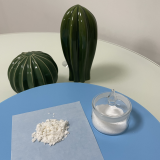Chinese VersionGold Suppliers > Hubei new DE sheng material science and technology co., LTD. > The use of biological buffer EPPS
- Search Product
-
-
- Region :Other Chemicals/Others
- Tel : 86-18971041571
- Fax :
- Email :vickyzhao@whdschem.com
- URL :
- Details for China The use of biological buffer EPPS
-
The use of biological buffer EPPS 16052-06-5
Category : Other Chemicals/Others

CAS NO : 16052-06-5 EC NO : 240-198-8 MF : C9H20N2O4S MW : 252.3311 Specification : White Powder Packing : 500g/bottle Product description : EPPS, also known as N - (2-hydroxyethyl) piperazin-N '-3-propanesulfonic acid, is an important buffering agent with a CAS of 16052-06-5 and a molecular weight of 252.33. Due to its excellent buffering performance, it is widely used in fields such as biochemistry, molecular biology, and biomedical research, making it an indispensable product in laboratories. What are its uses exactly? Let's take a look together. EPPS buffer is commonly used in DNA and RNA screening systems. DNA and RNA research is one of the core studies in the fields of biology and molecular biology, and the use of EPPS enables researchers to conduct experiments under specific pH conditions, ensuring the accuracy and reproducibility of experimental results. EPPS buffer has a wide range of applications in the study of electron transfer and phosphorylation in chloroplast thin layer preparation. Chloroplasts are crucial organelles for photosynthesis in plant cells. Studying the function and biochemical processes of chloroplasts is crucial for understanding plant growth and development. EPPS buffer can provide a stable chemical environment, which helps maintain the smooth progress of experiments. Due to the potential interference of methemoglobin on experimental results, EPPS buffer is very useful in preparing protein samples and can be used to protect oxygenated hemoglobin from oxidation to methemoglobin during freeze-drying. EPPS can also be used as a background electrolyte for capillary zone electrophoresis for protein microanalysis. Capillary zone electrophoresis is an efficient analytical technique widely used in biochemical and molecular biology research. EPPS, as a background electrolyte, helps maintain the stability and reproducibility of the analysis. From the above applications, EPPS buffer has a wide range of applications in DNA and RNA research, chloroplast research, protection of oxygenated hemoglobin, capillary zone electrophoresis, and other fields. Its superior performance makes it a hot product in the market, and when choosing, it is important to carefully consider manufacturers with stable supply. Uses : Biological buffer Synonyms : 3-[4-(2-Hydroxyethyl)-1-piperazine]propanesulfonic acid;4-(2-Hydroxyethyl)-1-piperazinepropanesulfonic acid;HEPPS N-(2-Hydroxyethyl)piperazine-N-3-propanesulfonic acid;N-(2-Hydroxyethyl)-N-(3-sulfopropyl)-piperazine;HEPPS, ULTROL Grade;HEPPS~4-(2-Hydroxyethyl)-1-piperazinepropanesulphonic acid;aEPPS;HEPPS;3-[4-(2-hydroxyethyl)piperazin-1-yl]propane-1-sulfonic acid;4-(2-Hydroxyethyl) piperazine-1-propanesulfonic acid; Molecular Structure : 
- more>>Other Products
-
- • Biological buffer 3- [N, N-di (hydroxyethyl) amino] -2-hydroxypropanesulfonic acid DIPSO
- • Luminol Sodium Salt
- • 4-Aminophthalhydrazide
- • acridinium ester DMAE-NHS
- • acridinium ester NSP-DMAE-NHS
- • Acridine hydrochloride NSP-SA
- • Acridine hydrochloride NSP-SA-NHS
- • NSP-SA-ADH
- • acridinium ester ME-DMAE-NHS TOOS; 3-(N-Ethyl-3-Methylanilino)-2-Hydroxypropanesulfonic Acid Sodium Salt
- • TOPS; Sodium 3-(N-Ethyl-3-Methylanilino)Propanesulfonate; N-Ethyl-N-Sulfopropyl-M-Toluidine Sodium Salt
- • ADOS Sodium 3-(Ethyl(3-Methoxyphenyl)Amino)-2-Hydroxypropane-1-Sulfonate Dihydrate
- • ADPS N-Ethyl-N-(3-Sulfopropyl)-3-Methoxyaniline Sodium Salt
- • ALPS N-Ethyl-N-(3-Sulfopropyl)Aniline Sodium Salt; Sodium 3-(Ethyl(Phenyl)Amino)Propane-1-Sulfonate; Sodium
- • DAOS; Sodium 3-((3,5-Dimethoxyphenyl)(Ethyl)Amino)-2-Hydroxypropane-1-Sulfonate
- • HDAOS; N-(2-Hydroxy-3-Sulfopropyl)-3,5-Dimethoxyaniline Sodium Salt
- • MADB N,N-Bis(4-Sulfobutyl)-3,5-Dimethylaniline Disodium Salt
- • MAOS N-Ethyl-N-(2-Hydroxy-3-Sulfopropyl)-3,5-Dimethylaniline Sodium Salt Monohydrate
- • DAB 3,3',4,4'-Biphenyltetramine Tetrahydrochloride